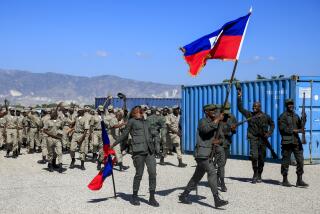CRISIS IN THE CARIBBEAN : U.S. Forces in Cap Haitien Confront a Difficult Mop-Up Operation : Assistance: As residents and Marines get used to each other, garbage collection proves fascinating to the citizenry.
- Share via
CAP HAITIEN, Haiti — Pfc. Joe Gowans from New York was trying hard to keep his cool.
The road was full of human excrement, urine and the putrid remains of orange rinds left from Wednesday’s meals in this northern Haitian city. The piles were as high as a man’s head.
And at the intersection of Rue Lafoset and Bridge No. 9, hundreds of Haitians were surging around Gowans and his tank crew.
All day long, men, women and children in rags and bare feet had been pushing forward to see the miracle of 20th-Century American know-how that the Marines had brought with them to this Caribbean island nation: a garbage truck.
On Tuesday, the Marines landed here in Haiti’s second-largest city, securing the airfield and seaport.
On Wednesday, they began to fan out on street patrols. Wednesday was also trash day, something the poor of Cap Haitien had never seen.
Their garbage--what the dogs, goats and roosters did not get--had clogged the streets for weeks and months, probably longer. Bicycle and pedestrian traffic was almost at a standstill.
Now the Marines, including 24-year-old Gowans, were going to clean it up. As his men began scooping up the refuse into a large green truck for dumping outside the city, Gowans watched in disbelief at what he saw.
Men and women in the crowd quickly urinated on the piles one last time before the trash could be removed. Children ran through the streets.
“How can you feel anything about these people?” Gowans asked. “They made this mess, and now we’ve got to clean it up. . . . We can help them. But we can’t do it all, and they’ve got to help themselves, and I don’t know if they can.”
Throughout the city, Marines and the people of Cap Haitien were trying to learn to live with one another as hover landing craft and Black Hawk helicopters continued to arrive in this Third World Hades. Gawkers remained, but many residents were growing restless not so much over seeing so many Marines as hearing them.
“How much longer?” yelled one man, his gray shirt dark with sweat, his breath heavy with the smell of bad rum. “How much longer do we have to hear that?” he yelled, pointing to the Cobra helicopters chop-chopping overhead.
In the Marine compound at the seaport, Rear Adm. William Wright IV said a force of 1,300 Marines supported by 130 armored vehicles will remain in Cap Haitien until the weekend. They will be replaced, he added, by 5,000 Army troops from the 10th Mountain Division. The soldiers are to perform peacekeeping duties as the U.S. military settles in.
Wright is running the amphibious Marine landing here. On Wednesday afternoon, he hosted Lt. Gen. Hugh Shelton, the overall U.S. commander in Haiti, and U.S. Ambassador William L. Swing on a tour of operations in the north.
Shelton had met earlier in the day with Haitian army chief Raoul Cedras in Port-au-Prince to deliver the message that the United States will not tolerate any human rights abuses such as the beatings of peaceful demonstrators by local police and army troops that occurred in the capital on Tuesday.
“We told him that we think that kind of thing is deplorable,” Shelton said.
Swing noted that Cap Haitien is isolated and not as tightly controlled by the military regime in Port-au-Prince.
“But we have a whole caseload of things we still have to do here,” Swing said. “And so far we have only uncorked the bottle.”
Wright said in an interview that the landing Tuesday took 12 hours. But he stressed how relieved military officials were that the landing occurred in daylight and was not a nighttime invasion, as originally planned.
With the dense population crowded into swampland slums, he said, a night invasion would probably have caused numerous casualties as Marines groped their way through the city.
“It would have been very, very difficult,” he said. “I am sure we would have had some firefights with colossal damage. It’s frightening to think about it. So I guess some of these things in life have a way of working out.”
The admiral said the only medical attention needed by any Marines had been for heatstroke that occurred as they dug trenches for hours in the humid, tropical climate.
He added that there have only been two problems with local residents. A Cap Haitien policeman who was being jeered by a large crowd at the port drew his weapon, crouched and threatened to fire.
“A Marine stepped in and drew his weapon and told him he would not allow that kind of thing,” Wright said.
In the second incident, Marines broke up a fight in which a woman was being beaten on the head with a whip.
“As soon as this ended, the crowd cheered us,” Capt. Rich Diddams said.
There was no cheering for Gowans and his dump truck, but Sgt. Douglas Wilbert, 28, from Princeton, Iowa, said he felt good about this operation nevertheless.
He said even being a garbage man is a form of humanitarian assistance: “We’re serving our purpose.”
Gowans agreed, saying, “We could have been picking up bodies off the street.”
More to Read
Sign up for Essential California
The most important California stories and recommendations in your inbox every morning.
You may occasionally receive promotional content from the Los Angeles Times.














